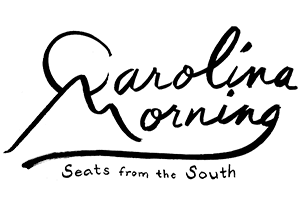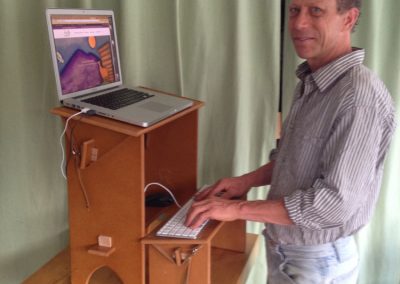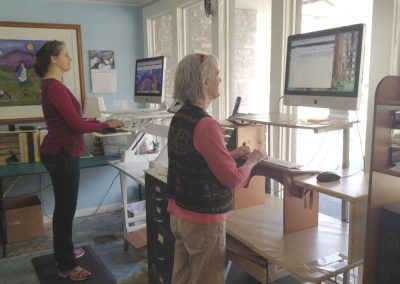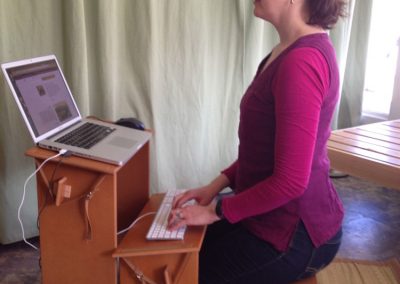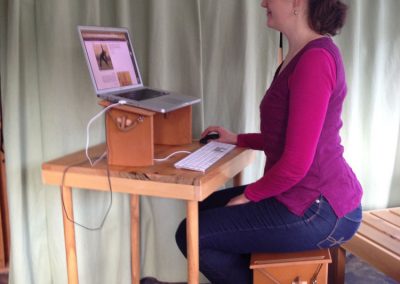When I was in highschool I got rid of the furniture in my bedroom and starting sitting and sleeping on the floor. I was exploring ways of arranging my space and using my body that felt more grounded and natural. Even now, I’m reluctant to sit on furniture. People say “there’s a couch”, as if they feel sorry for me, perhaps are thinking I’m depriving myself, or I somehow didn’t notice. Likewise, I will be out walking and people will offer me a ride or they will ask, “Don’t you have a car?”
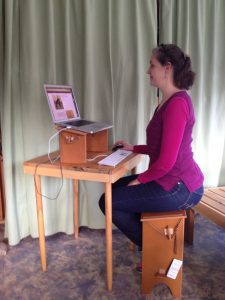
Solution 1: ACTIVE SITTING at a standard desk using the Tilt Seat as the chair and the Peace Bench as the laptop podium.
There is a dominant paradigm orientation in western culture that believes it is better to drive than to walk, and it is better to sit on a couch than on the floor. Americans spend an average of 9.1 hours per day sitting. The fitness industry probably arose as a search for some way to remedy this sedentary lifestyle instigated by the Industrial Revolution that moved people from farming to sitting. By making life so easy using technology to take physical work (healthy movement) out of the picture…we have destroyed a critical factor in health. Recent research from a variety of places has confirmed my own instinctual minimalist orientation. Dr. Verticos, NASA scientist and author of Sitting Kills, says, “Exercise is no remedy for chronic sitting. Our body needs perpetual motion….The key to lifelong health is to rediscover a lifestyle of constant, natural, low intensity, non-exercise movement that uses the gravity vector throughout the day.”
What she means by the gravity vector is the act of going from the floor to standing, or from a chair to standing and back. This is extremely beneficial. The gravity vector is also used when walking up or down stairs or jumping or anything that is moving from up to down or back down. Her point is that when we sit in a chair for long periods we are in a similar state as astronauts in space who are away from the beneficial effects of gravity. One of the main reasons astronauts age rapidly is due to lack of gravity. Modern conveniences deliver whatever we need with no work. Furniture which raises off the floor, like beds and chairs, deprives us of the opportunity to bend over or get up off the ground.
Another researcher, Katy Bowman has turned up startling research that further supports the “sitting is bad for you” hypothesis. Her book Move Your DNA, spells out in detail the catastrophe of the modern sit down lifestyle. She says movement is more important than exercise. And exercise is not movement. Exercise, the kind of thing you do once a day because it is good for you, does not replace what is more important, and is missing from our lives–constant movement in a variety of directions all day long. Without it the body breaks down on every level, including the DNA. You can’t get around it…the effects of sitting for hours per day cannot be undone by an exercise session at another time. Katy coined the term “Movement Nutrition” to describe her concept. Exercise is too much of too few movements.
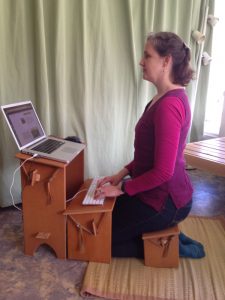
Solution 2 FLOOR SITTING using three props: Peace Bench™ for kneeling, Sky Bench™ for keyboard holder, and Tilt Seat™ for laptop desk. This is the most ideal position where the keyboard and screen are closest to ideal levels.
Moving the same way over and over in the same way for too long as in treadmills, bicycles, and other exercise equipment actually causes its own problems. It is better than sedentary alone, but it does not lead to optimal health. The solution is to do a variety of movements such as squatting and kneeling on the floor, bending over to pick things up or gather berries, climbing trees, running and jumping on logs and rocks. The body has been shaped by years of using it in a way that leads to a progressive humping of the back and jutting forward of the head. This comes with several names such as “upper-crossed syndrome”, “front loading,” “c-shaped slump”. What starts out as an imperceptible reshaping of the body often leads to:
- Chronic and debilitating pain (80% of Americans will experience chair-related back pain in their lifetime.)
- Herniated and bulging disks in the lower back
- The muscles needed to do things like bend and sit are atrophied
- The muscles which hold us in the right angled seated position are tight and locked into place.
An individual often cannot just suddenly make the transition to healthy movement without some guidance. Carolina Morning offers a number of products that can gently awaken the innate wisdom of the body. We offer four distinct approaches to customize your own working environment. We encourage shifting your body position periodically so that movement and balance become the everyday norm of computer work.
*********************************
Stand Up Desk Tilt Seat Peace Bench
Solution 3: The TIlt Seat is used to hold the laptop screen and the Peace Bench is used for the keyboard. The mouse is placed on the lower shelf of the Tilt Seat.
Floor Lounging Eco Backrest
Solution 4: This is another way to use the Tilt Seat/ Eco Backrest combination which works better for getting up and down. Who wouldn’t want to lean back like this now and then when you’ve got a project to work on or want to watch a video?
Eco Backrest Laptop Station
Solution 4: A fun way to relax even while you work using Tilt Seat as laptop desk and EcoBackrest for superb comfort.
Co working Standup Desks
Solution 3: Staff members Bethany (L) and Linsi (R) using stand up desks at Carolina Morning
Floor Sitting Zen Office Delux
Solution 2: Floor Sitting using three props: Peace Bench for kneeling, Sky Bench for keyboard holder, and Tilt Seat for laptop desk. This is the most ideal position where the keyboard and screen are closest to ideal levels. This position also give a feeling of solidness for power and focus.
